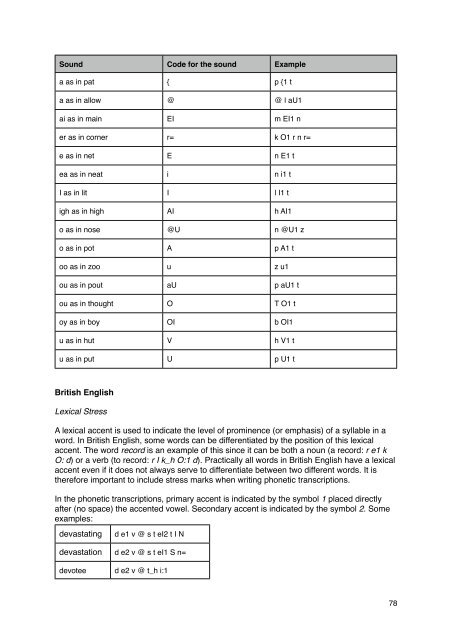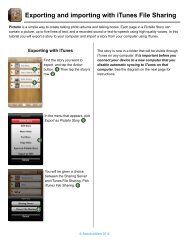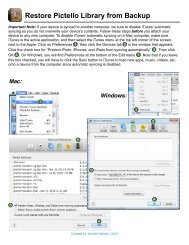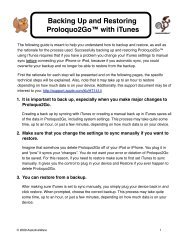Proloquo2Go Manual 2.3_Nov_23 - AssistiveWare
Proloquo2Go Manual 2.3_Nov_23 - AssistiveWare
Proloquo2Go Manual 2.3_Nov_23 - AssistiveWare
You also want an ePaper? Increase the reach of your titles
YUMPU automatically turns print PDFs into web optimized ePapers that Google loves.
Sound Code for the sound Example<br />
a as in pat { p {1 t<br />
a as in allow @ @ l aU1<br />
ai as in main EI m EI1 n<br />
er as in corner r= k O1 r n r=<br />
e as in net E n E1 t<br />
ea as in neat i n i1 t<br />
I as in lit I l I1 t<br />
igh as in high AI h AI1<br />
o as in nose @U n @U1 z<br />
o as in pot A p A1 t<br />
oo as in zoo u z u1<br />
ou as in pout aU p aU1 t<br />
ou as in thought O T O1 t<br />
oy as in boy OI b OI1<br />
u as in hut V h V1 t<br />
u as in put U p U1 t<br />
British English<br />
Lexical Stress<br />
A lexical accent is used to indicate the level of prominence (or emphasis) of a syllable in a<br />
word. In British English, some words can be differentiated by the position of this lexical<br />
accent. The word record is an example of this since it can be both a noun (a record: r e1 k<br />
O: d) or a verb (to record: r I k_h O:1 d). Practically all words in British English have a lexical<br />
accent even if it does not always serve to differentiate between two different words. It is<br />
therefore important to include stress marks when writing phonetic transcriptions.<br />
In the phonetic transcriptions, primary accent is indicated by the symbol 1 placed directly<br />
after (no space) the accented vowel. Secondary accent is indicated by the symbol 2. Some<br />
examples:<br />
devastating d e1 v @ s t eI2 t I N<br />
devastation d e2 v @ s t eI1 S n=<br />
devotee d e2 v @ t_h i:1<br />
78






